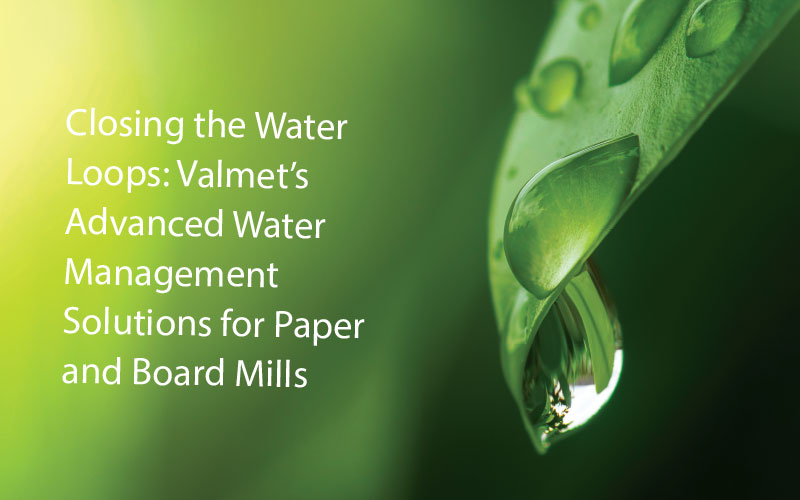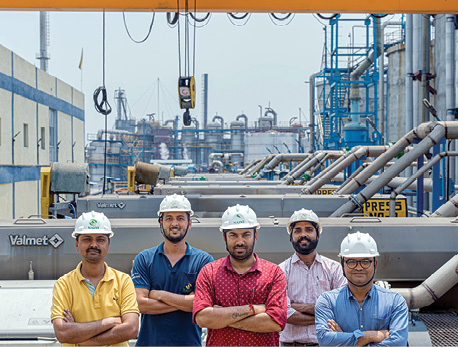Valmet provides comprehensive water management solutions to pulp and paper mills enabling the mills to increase their water reuse and significantly reduce their effluent discharge. Valmet’s fiber recovery solutions, including disc filters, allow mills to reclaim valuable fibers from process water, minimizing material loss and environmental impact.

Paper Mart: How has your understanding or approach to water circularity evolved over time? How are you helping mills move closer to achieving it?
Valmet: Valmet’s approach to water circularity has evolved from traditional water-saving practices to a comprehensive, system-wide strategy aimed at reducing fresh water use in industrial operations. Initially focused on optimizing individual processes to reduce freshwater intake, Valmet has over time integrated water management into its broader sustainability and circular economy goals. Together with our partner Flootech, we support mills with water management concepts that include advanced water treatment solutions enabling greater water reuse and reduced effluent discharge.
Additionally, Valmet leverages its industrial internet solutions for real-time monitoring of production processes. By combining process innovation, digital tools, services and collaborative R&D, Valmet is helping customers move steadily toward more sustainable, low-water-footprint production.
PM: How widely are circular water systems being adopted in paper mills? What adoption trends are you noticing?
V: Paper mills have become increasingly interested in lowering their water footprint and this trend can be seen in many geographical areas all over the world. Technological development is heading towards near-closed water loops.
Biological water treatment systems are commonly used in the effluent treatment plants of paper mills. These systems effectively reduce chemical oxygen demand (COD), biological oxygen demand (BOD), and volatile suspended solids (VSS). Paper mills with limited access to freshwater often recirculate biologically treated water back into the production process. For example, Old Corrugated Container (OCC) mills increase reuse of biologically treated water in the stock preparation phase.
Ultrafiltration and dissolved air flotation (DAF) are key technologies in paper machine water treatment. DAF removes fines and pitch, ultrafiltration removes solids, colloids, sticky substances and bacteria. The permeate from the ultrafiltration can be used in paper machine showers instead of fresh water. However, to incorporate these methods into the paper machine water cycle, overall water system optimization must first be completed. AI monitoring for individual processes in paper mills is currently being developed.
Watch: In Pursuit of Lesser Water Footprint
PM: Based on your experience, which current technologies are having the greatest real-world impact in improving water circularity in paper mills?
V: Membrane filtration, such as ultrafiltration, is enabling mills to recycle high-quality process water internally, significantly reducing freshwater intzake. Fiber recovery technology, like Valmet’s disc-filters, is helping mills reclaim valuable fibers from water streams while minimizing waste.
Valmet’s Save-all disk filters ensure fiber recovery and clear filtrate production for returning it back to the process. Screw presses and TwinRoll presses maximize pulp dewatering and washing efficiency and thus reduce water consumption and pollution load in subsequent stages of paper production.
PM: What are the key challenges your clients face in improving water management or achieving circularity?
V: Customers aiming to improve water management and achieve greater circularity often face several key challenges, including high investment costs, technical complexity, and operational risks. Many mills, especially older ones, have legacy systems that are not easily adaptable to closed-loop water processes without significant retrofitting.
In some cases, inconsistent water quality due to variations in raw materials or process conditions makes stable recycling difficult without advanced treatment and monitoring. Additionally, regulatory uncertainties can make it hard for mills to justify major investments without clear long-term policy support. Overall, while the desire for circular water management is strong, practical, financial, and technical hurdles must be carefully navigated to achieve it.

Our mills have conducted a detailed Water Pinch Analysis (WPA) in collaboration with the Confederation of Indian Industry (CII) to optimize water usage and minimize wastewater generation in industrial processes. This analysis helped us identify approximately 5,000 m³ per day of potential water savings.
PM: How are environmental regulations influencing demand for circular water systems? Are you seeing more compliance-driven innovation?
V: Environmental regulations are playing a major role in driving demand for circular water systems in the pulp and paper industry, pushing mills to adopt more sustainable water management practices. Stricter discharge limits, water usage caps, and requirements for effluent quality are compelling mills to invest in technologies that minimize fresh water intake and maximize water reuse.


PM: Can you share examples of cost or efficiency gains achieved by mills using your systems for water recycling?
V: Naini Papers Limited, for instance, started up its new Valmet cooking, fiberline, recausticizing, and lime kiln equipment in 2021. They implemented eight Valmet TwinRoll presses in the fiberline. These technologies have enabled the mill to reduce freshwater consumption from a target of less than 9.5 to less than 9 m3 per air-dried tonne.
Another strong example is Tamil Nadu Newsprint and Papers Limited (TNPL). The Valmet TwinRoll press technology has proved to reduce water, energy and chemical demand in their new bleached hardwood kraft pulp line, commissioned in 2022.
Older OCC mills can consume about 10 cubic meters (m³) of freshwater per ton of produced board. In contrast, modern OCC lines can be designed to consume about 3 m³ of freshwater per ton or even less in special cases. For a large modern mill with an annual production of 700,000 tons of board, this results in an annual freshwater consumption reduction of about 5 million cubic meters compared to older mills.
PM: How do you co-create solutions with mills? Are there examples of partnerships that led to better water management outcomes?
V: One recent example is Valmet ‘s partnership with Grasim Industries Limited focused on reducing freshwater usage and effluent through delivering a new bleach plant, and an evaporation and wash plant rebuild, with installation planned for the first quarter of 2026.
The new bleach plant, which includes five TwinRoll presses and Valmet HC Ozone Bleaching, helps achieve high brightness and reduce effluent discharges. Furthermore, the upgrade of the evaporation and wash plants will enhance process efficiency, increase yield, improve energy efficiency, and support Grasim’s environmental goals by minimizing freshwater usage and increasing the process water circulation.
PM: Looking ahead, which emerging technologies or innovation models (such as digital twins, decentralized systems, or AI/IoT platforms) could radically improve water circularity in the next 5–10 years?
V: Looking ahead, emerging technologies such as digital twins, decentralized systems, and AI/IoT platforms have the potential to radically improve water circularity in the next 5–10 years.
Digital twins could enable real-time simulation and optimization of water systems by creating virtual replicas of entire water cycles within mills, allowing operators to test different scenarios, predict failures, and optimize water use without physically disrupting operations.
Decentralized water treatment systems powered by advanced filtration and biological treatment methods could provide more localized, scalable solutions, enabling mills to treat and reuse water directly within smaller, modular units, reducing dependency on centralized treatment plants. Additionally, AI/IoT platforms will drive more efficient water management through continuous monitoring, predictive maintenance, and intelligent decision-making, helping mills to dynamically adjust water flows, chemical usage, and treatment processes based on real-time data.
These innovations, combined with advances in membrane technology and energy-efficient processes, promise to make circular water systems more accessible, cost-effective, and adaptable to a broader range of mill operations.
Real-time monitoring and control of treatment processes ensures optimal performance as well as automation minimizes human error and allows for consistent quality in effluent discharge. Automated systems can track and log data continuously making it easier to comply with environmental regulations and reporting requirements as well as automated systems alarm operators about the deviations. Remote monitoring and operations are important features in the future.

Stricter discharge limits, water usage caps, and requirements for effluent quality are compelling mills to invest in technologies that minimize fresh water intake and maximize water reuse.



